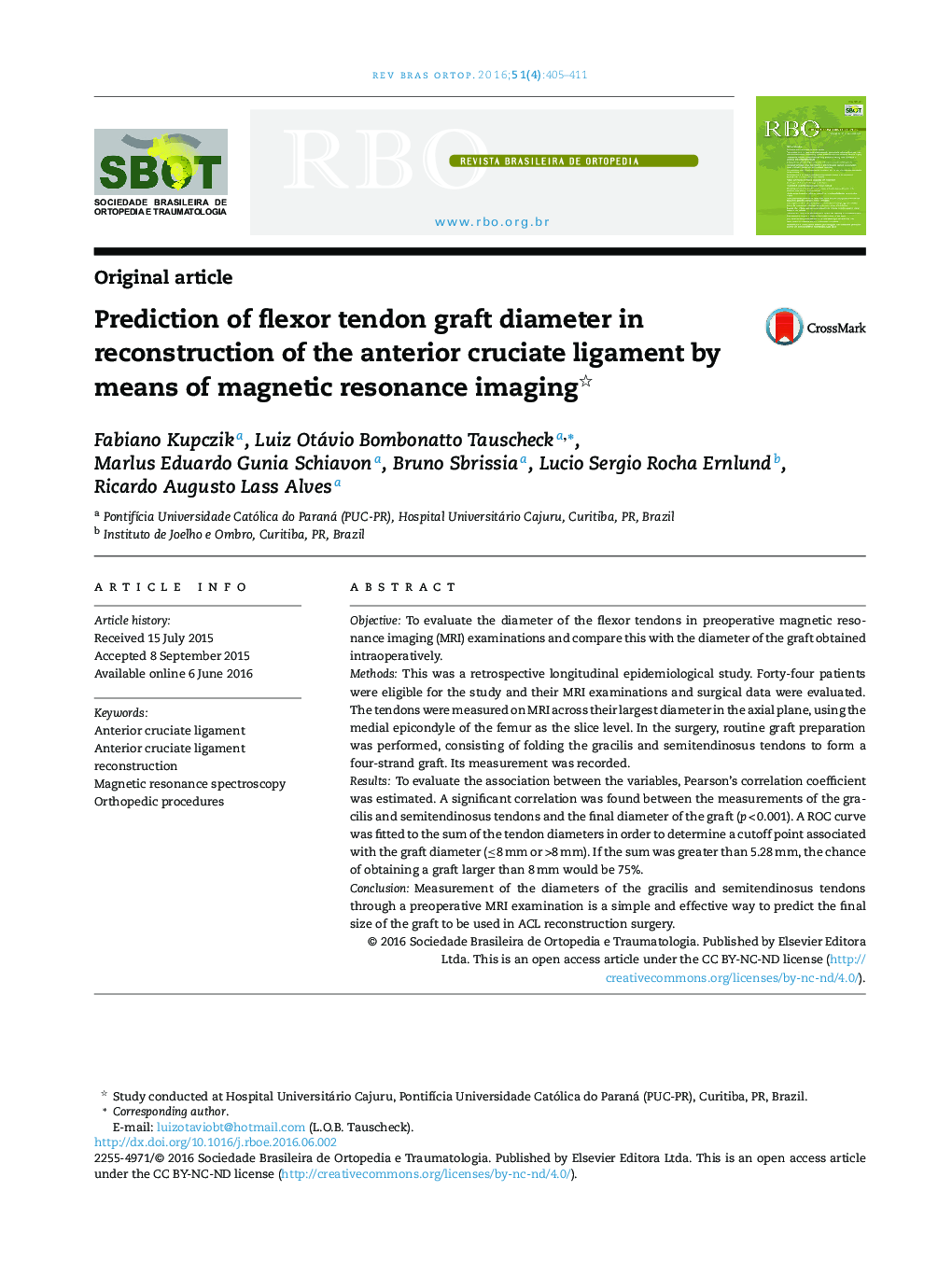| کد مقاله | کد نشریه | سال انتشار | مقاله انگلیسی | نسخه تمام متن |
|---|---|---|---|---|
| 2707815 | 1565452 | 2016 | 7 صفحه PDF | دانلود رایگان |
ObjectiveTo evaluate the diameter of the flexor tendons in preoperative magnetic resonance imaging (MRI) examinations and compare this with the diameter of the graft obtained intraoperatively.MethodsThis was a retrospective longitudinal epidemiological study. Forty-four patients were eligible for the study and their MRI examinations and surgical data were evaluated. The tendons were measured on MRI across their largest diameter in the axial plane, using the medial epicondyle of the femur as the slice level. In the surgery, routine graft preparation was performed, consisting of folding the gracilis and semitendinosus tendons to form a four-strand graft. Its measurement was recorded.ResultsTo evaluate the association between the variables, Pearson's correlation coefficient was estimated. A significant correlation was found between the measurements of the gracilis and semitendinosus tendons and the final diameter of the graft (p < 0.001). A ROC curve was fitted to the sum of the tendon diameters in order to determine a cutoff point associated with the graft diameter (≤8 mm or >8 mm). If the sum was greater than 5.28 mm, the chance of obtaining a graft larger than 8 mm would be 75%.ConclusionMeasurement of the diameters of the gracilis and semitendinosus tendons through a preoperative MRI examination is a simple and effective way to predict the final size of the graft to be used in ACL reconstruction surgery.
ResumoObjetivoAvaliar o diâmetro dos tendões flexores em exames de ressonância magnética (RNM) pré-operatória e comparar com o diâmetro do enxerto obtido no ato intraoperatório.MétodosEm um estudo epidemiológico longitudinal retrospectivo, 44 pacientes foram elegíveis ao estudo e tiveram os exames de RNM e dados de cirurgias avaliados. Os tendões foram medidos na RNM no seu maior diâmetro no plano axial com o uso do epicôndilo medial do fêmur como nível de corte. Na cirurgia foi feito preparo de rotina do enxerto, dobraram-se os tendões grácil e semitendinoso, formou-se um enxerto quádruplo que teve sua medida registrada.ResultadosPara a avaliação da associação entre as variáveis foi estimado o coeficiente de correlação de Pearson. Foi encontrada correlação significativa entre as medidas dos tendões grácil e semitendinoso e o diâmetro final do enxerto (p < 0,001). Ajustou-se uma curva ROC para a soma do diâmetro dos tendões, para a determinação de um ponto de corte associado ao diâmetro do enxerto (≤ 8 mm ou > 8 mm). Caso a soma seja maior do que 5,28 mm, a chance de obter um enxerto maior do que 8 mm é de 75%.ConclusãoA medida do diâmetro dos tendões grácil e semitendinoso no exame da RNM pré-operatória é uma maneira simples e eficaz na predição do tamanho final do enxerto a ser usado na cirurgia de reconstrução do LCA.
Journal: Revista Brasileira de Ortopedia (English Edition) - Volume 51, Issue 4, July–August 2016, Pages 405–411
